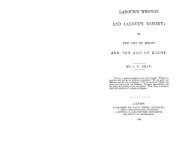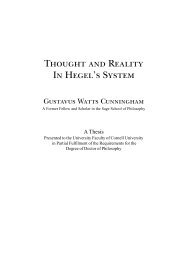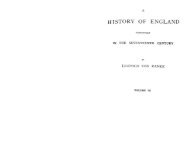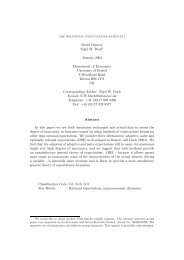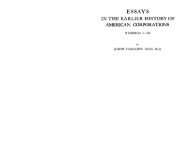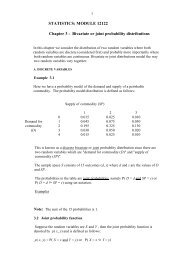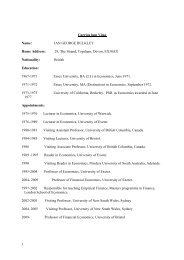TEXTILES TEXTILES I37hours in four and twenty, and had much rather doit than be idle.'The work developed until " He enlyloyed in thismanufacture some times 1600, some times 1700Spinners, besides Dressers <strong>of</strong> flax, Weavers and others.Because he found that his Poor must work sixteenhours in the day to earn sixpence, and thought theirnecessities and labour -were not sufficiently suppliedor recompensed by these earnings ; therefore he waswont to distribute Charity among them . . .without which Charity some <strong>of</strong> them had perishedfor want, when either they or their children fell ill. . . . Whoever <strong>of</strong> the Spinners brought in twopound <strong>of</strong> Yarn might take away with 'em a Peck<strong>of</strong> Coals. Because they soiled themselves by carryingaway Coals in their Aprons or Skirts . . . . hegave 'em canvass bags. By the assistance and order<strong>of</strong> his Friends he gave to Men, Women and Children3,000 Shirts and Shifts in two years."'laid out the last Year, reckning" In above E~OOO,I-louse-rent, Servants wages, Loss by Learners, withthe interest <strong>of</strong> the Money, there was not above E200lost, one chief reason <strong>of</strong> which was the kindness <strong>of</strong>several Persons, who took <strong>of</strong>f good quantities . at the price they cost me to spin and weave . . . .and . . . . the East India Co., gave en-couragement to make their bags."But the lossincreased as time went on . . . . " In 1699 hisdesign <strong>of</strong> employing the poor to spin flax was takenup by the Patentees <strong>of</strong> the Linen Manufacture,who made the Poor and others, whom they employed,to work cheaper ; yet that was not sufficient toencourage them to continue the manufacture . .The poor spinners, being thus deserted, Mr. Firminreturned to 'em again; and managed that trade asl Firmin, Thomas, L*, pp. 31-32? 1698.' Ibid, pp 31-2, 1698.he was wont ; But so, that he made it bear almostits own Charges. But that their smaller Wagesmight be comfortable to them he was more Charitableto 'em, and begged for 'em <strong>of</strong> almost all Persons <strong>of</strong>Rank with whom he had intimacy, or so much asFriendship. He would also carry his Cloth to divers,with whom he scarce had any acquaintance, telling'em it war the Poor's cloth, which in conscience theyought to buy at the Price it could be aforded."' . . .Finally, " he was persuaded by- some, to make trial<strong>of</strong> the Woollen Manufactz~re; because at this, the Poormight make better wages, than at Linen-work.But the price <strong>of</strong> wool advancing very much, and theLondon-Spinsters being almost wholly unskilful atDrawing a Woollen-Thread, after a considerable. . . . and 29 months trial he gave <strong>of</strong>flossthe proje~t."~Firmin's experiment, corroborating as it does theresults <strong>of</strong> other efforts at poor relief, shows that atthis time <strong>women</strong> could not maintain themselves bythe wages <strong>of</strong> flax spinning; still less could they,when widows, provide for their children by thismeans.But though the spinster, when <strong>working</strong> for wagesreceived so small a return for her labour, it must notbe forgotten that flax spinning was chiefly a domesticart, in which the whole value <strong>of</strong> the woman's labourwas secured to her family, unaffected by the rate<strong>of</strong> wages. Therefore the value <strong>of</strong> <strong>women</strong>'s labourin spinning flax must not be judged only accordingto the wages which they received, but was more trulyrepresented by the quantity <strong>of</strong> linen which theyproduced for household use.' Firmin (Thomas) Life, pp. 33-6.Ibid, pp. 39-10.
'38 TEXTILES TEXTILESD. Silk, and Gold and Silver.THE history <strong>of</strong> the Silk Trade differs widely fromthat <strong>of</strong> either the Woollen or Linen Trades. The con-ditions <strong>of</strong> its manufacture during the fifteenth <strong>century</strong>are described with great clearness in a petition presentedto Henry V1. by the silk weavers in 1455, which" Sheweth unto ioure grete wisdoms, and also prayenand besechen the Silkewymmen and Throwestres <strong>of</strong>the Craftes and occupation <strong>of</strong> Silkewerk within theCitee <strong>of</strong> London, which be and have been Craftes<strong>of</strong> wymmen within the same Citee <strong>of</strong> tyme that noomynde renneth unto the contrarie. That whereit is pleasyng to God that all his Creatures be set invertueux occupation and labour accurdyng to theirdegrees, and convenient for thoo places where theirabode is, to the nourishing <strong>of</strong> virtue and eschewyng<strong>of</strong> vices and ydelness. And where upon the same Crafres,before this tyme, many a wurshipfull woman withinthe seid Citee have lyved full hounourably, and therwithmany good Housholdes kept, and many Gentilwymmenand other in grete noumbre like as there nowe bemoo than a M., have been drawen under theym inlernyng the same Craftes and occupation full vertueusly,unto the plesaunce <strong>of</strong> God, whereby afterward theyhave growe to grete wurship, and never any thing<strong>of</strong> Silke brought into yis lande concerning the sameCraftes and occupation in eny wise wrought, but inrawe Silk allone unwrought " ; but now wrought goodsare introduced and it is impossible any longer to obtainrawe material except <strong>of</strong> the worst quality . . . ." the suff eraunce where<strong>of</strong>, hath caused and is like tocause, grete ydelness amongs yange Gentilwymmenand oyer apprentices <strong>of</strong> the same Craftes within yesaid Citee, and also leying doun <strong>of</strong> many good and notableHousholdes <strong>of</strong> them that have occupied the sameCraftes, which be convenient, worshipful1 and accordyngfor Gentilwymmen, and oyer wymmen <strong>of</strong> wurship, aswelewithin ye same Citee as all oyer places within thisReaume." The petitioners assumed that " Everywele disposed persone <strong>of</strong> this land, by reason and natural1favour, wold rather that wymmen <strong>of</strong> their nation bornand owen blode hadde the occupation there<strong>of</strong>, thanstrange people <strong>of</strong> oyer landes."'The petition received due attention, Statute 33,Henry V1 enacting that " W-hereas it is shewed toour Sovereign Lord the Ring in his said parliament,by the grevous complaint <strong>of</strong> the silk <strong>women</strong> andspinners <strong>of</strong> the mystery and occupation <strong>of</strong> silk-<strong>working</strong>, within the city <strong>of</strong> London, how that diversLombards and other strangers, imagining to destroythe said mystery, and all such virtuous occupations<strong>of</strong> <strong>women</strong> in the said Realm, to enrich themselves. . . . have brought . . . . such silk somade, wrought, twined, ribbands, and chains falselyand deceitfully wrought, all manner girdels and otherthings concerning the said mystery and occupation,in no manner wise bringing any good silk unwrought,as they were wont." Therefore the importation <strong>of</strong>"any merchandise . . . . . . touching orconcerning the mystery <strong>of</strong> silk <strong>women</strong>, (girdelswhich come from ~enoa only excepted,)" isf~rbidden.~This statute was re-enacted in succeeding reignswith the further explanation that " as well men as<strong>women</strong> " gained their living by this trade.Few incidents reveal more clearly than do thesepetitions the gulf separating the conception <strong>of</strong> <strong>women</strong>'ssphere in <strong>life</strong> which prevailed in mediaeval London, fromthat which governed society in the first decade <strong>of</strong>the.twentieth <strong>century</strong>. The contrast is so great that itbecomes difficult to adjust one's vision to the implicationswhich the former contains. Other incidentsl Rolls <strong>of</strong>Parliament, V., 325. A Pettition <strong>of</strong>silk Weavers, 34 Henry VI., c. 55.Statutes, II., p. 374, 33 Henry VI., c. 5.
- Page 1 and 2:
WORKING LIFE OF WOMENIN THESEVENTEE
- Page 6 and 7:
4 INTRODUCTORYtragic class of wage
- Page 8 and 9:
8 INTRODUCTORY INTRODUCTORYDomestic
- Page 10 and 11:
INTRODUCTORYunmarried girls go out
- Page 12 and 13:
I 6 CAPITALISTS CAPITALISTS" I loos
- Page 14 and 15:
CAPITALISTSweak woman stands in the
- Page 16 and 17:
24 CAPITALISTS CAPITALISTS 25wife t
- Page 18 and 19:
2 8 CAPITALISTS CAPITALISTS 29Majes
- Page 20 and 21:
32 CAPITALISTSA warrant was issued"
- Page 22 and 23: CAPITALISTSbusiness. " At O~tend, N
- Page 24 and 25: CAPITALISTS CAPITALISTS41thro' her
- Page 26 and 27: AGRICULTUREwas made of their develo
- Page 28 and 29: AGRICULTUREis not drye as it should
- Page 30 and 31: 52 AGRICULTURE AGRICULTUREhave of h
- Page 32 and 33: 56 AGRICULTUREfor colonists in Virg
- Page 34 and 35: AGRICULTUREmaintain completely the
- Page 36 and 37: 64 AGRICULTUREtime was well spent i
- Page 38 and 39: AGRICULTUREExcept in exeptional cir
- Page 40 and 41: 72 AGRICULTURE AGRICULTURE 73mainta
- Page 42 and 43: 76 AGRICULTUREfor the impotent poor
- Page 44 and 45: AGRICULTUREwhich we can imagine tha
- Page 46 and 47: AGRICULTURE AGRICULTURE 85by his se
- Page 48 and 49: AGRICULTUREher work, but generosity
- Page 50 and 51: AGRICULTUREwife of Thos. Lyne. Toba
- Page 52 and 53: TEXTILESwas paid better than the la
- Page 54 and 55: TEXTILESroof provided them with the
- Page 56 and 57: 104 TEXTILESformulated by 25 Charle
- Page 58 and 59: 108 TEXTILES TEXTILES 109until the
- Page 60 and 61: TEXTILESon spinning for their livin
- Page 62 and 63: TEXTILESstill and dry within Doors,
- Page 64 and 65: 120 TEXTILES TEXTILESthe cloth made
- Page 66 and 67: 124TEXTILES TEXTILESin the closely
- Page 68 and 69: TEXTILESKingdom, it required a grea
- Page 70 and 71: 132 TEXTILES TEXTILESnot exceedl6 1
- Page 74 and 75: ---P-I 4OTEXTILEScan be quoted of t
- Page 76 and 77: '44 TEXTILES TEXTILESWood Streate,
- Page 78 and 79: TEXTILEShigher wages than would hav
- Page 80 and 81: 1 52 CRAFTS AND TRADESdebts. For ex
- Page 82 and 83: I 56 CRAFTS AND TRADES CRAFTS AND T
- Page 84 and 85: 160 CRAFTS AND TRADES CRAFTS AND TR
- Page 86 and 87: 164 CRAFTS AND TRADESAmong thirty-n
- Page 88 and 89: CRAFTS AND TRADESalso met with as b
- Page 90 and 91: 172 CRAFTS AND TRADES CRAFTS AND TR
- Page 92 and 93: 176 CRAFTS AND TRADESto Henry Joyce
- Page 94 and 95: 180 CRAFTS AND TRADES CRAFTS AND TR
- Page 96: CRAFTS AND TRADESWardens and Brothe
- Page 99 and 100: P-I9OCRAFTS AND TRADESmarriage ; it
- Page 101 and 102: CRAFTS AND TRADEStaken our goods fr
- Page 103 and 104: 1g8CRAFTS AND TRADESresources turne
- Page 105 and 106: CRAFTS AND TRADESThere were fewer r
- Page 107 and 108: 206 CRAFTS AND TRADES CRAFTS AND TR
- Page 109 and 110: CRAFTS AND TRADESA large proportion
- Page 111 and 112: 214CRAFTS AND TRADES CRAFTS AND TRA
- Page 113 and 114: 218 CRAFTS AND TRADES CRAFTS AND TR
- Page 115 and 116: 222 CRAFTS AND TRADES CRAFTS AND TR
- Page 117: CRAFTS AND TRADES CRAFTS AND TRADES
- Page 120 and 121: CRAFTS AND TRADESfrom her fellow pa
- Page 122 and 123:
PROFESSIONS 237PROFESSIONSIntroduct
- Page 124 and 125:
24O PROFESSIONS PROFESSIONStheir Th
- Page 126 and 127:
244 PROFESSIONS PROFESSIONS 245the
- Page 128 and 129:
PROFESSIONS PROFESSIONS 249profanat
- Page 130 and 131:
252PROFESSIONSGiles Moore enters in
- Page 132 and 133:
PROFESSIONScribed as one who " dist
- Page 134 and 135:
PROFESSIONS PROFESSIONS 261first ma
- Page 136 and 137:
264 PROFESSIONSGarrett's leg shall
- Page 138 and 139:
268 PROFESSIONSwhere there are none
- Page 140 and 141:
PROFESSIONS PROFESSIONS 273the numb
- Page 142 and 143:
PROFESSIONSexaminations, before six
- Page 144 and 145:
PROFESSIONS PROFESSIONS 281death me
- Page 146 and 147:
284 PROFESSIONS PROFESSIONSof confi
- Page 148 and 149:
288 PROFESSIONSextent they were whe
- Page 150 and 151:
CONCLUSIONor in her other facilitie
- Page 152 and 153:
CONCLUSION CONCLUSION 297in women's
- Page 154 and 155:
CONCLUSIONlaw of Nature, inviolable
- Page 156 and 157:
CONCLUSIONwere specially deprecated
- Page 158 and 159:
308 CONCLUSIONof the State, and the
- Page 160 and 161:
312 AUTHORITIES AUTHORITIES 313Cost
- Page 162 and 163:
AUTHORITIESMartindale, Adam, The Li
- Page 164 and 165:
County.Buckingham ..Cardigan .. ..C
- Page 166 and 167:
INDEXINDEXFlax, 64, 146, 246, 291 ;
- Page 168:
INDEXsmants, women( 50,65,157 ; mam



